
Ceviche vs. Aguachile Showdown: Decoding the Distinctions
Ceviche vs. Aguachile Showdown: Decoding the Distinctions
What is aguachile, and how is it different from ceviche?
In today’s post, I will answer this to the best of my knowledge (in fact, aguachile is one of my all-time favorite foods!).
If you happen to visit any of the Mexican beach towns, especially in the state of Sinaloa, you must look for the best restaurant recommended by the locals and try the aguachile.
Mazatlan (in Sinaloa) is undoubtedly the best place since this is considered the hometown of shrimp aguachile.
Mazatlan not only produces some of the best and freshest seafood in the country, but this is also the place where the aguachile dish saw the light for the first time.
Not to mention that 37% of the country’s shrimp production comes from this state.
It’s no wonder that the best aguachile in the country comes from Mazatlan.
Ceviche vs Aguachile: What’s the difference?
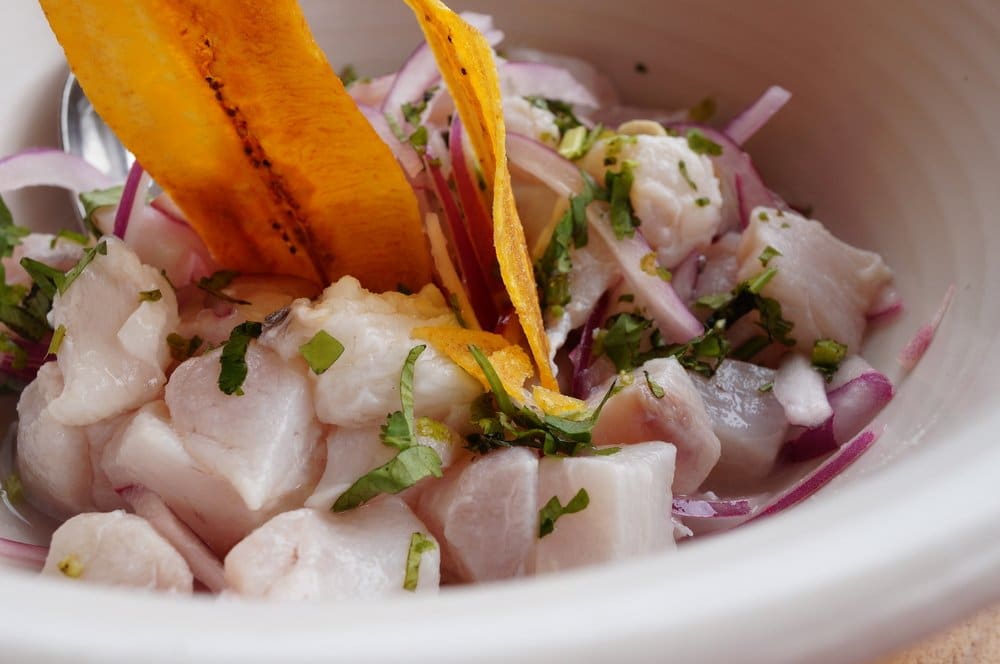
Although similar, these dishes have clear geographical differences, recipes, and ingredients.
Ceviche and aguachile mark every summer season in seafood restaurants in coastal towns or on a deck chair on the beach, but have you ever wondered how they differ?
Ceviche (or cebiche) is a dish made with pieces of fresh fish marinated in lemon juice or some other citrus fruit.
With the acid liquid, the meat protein is denatured; it becomes opaque and firmer. That’s why it is said that the lime juice “cooks” the fish.
Ceviche is accompanied by various condiments, depending on the region.
It is mainly produced on the Pacific coasts of Mexico, but it is also a characteristic dish in many Latin American countries.
It is also part of the food culture of Chile, Colombia, Costa Rica, Ecuador, El Salvador, Guatemala, Honduras, Nicaragua, Panama, and Peru -where it is considered a Cultural Heritage-.
In each of these places, ceviche is prepared with different accompaniments.
For example, in El Salvador, it is usually made with black pepper, onion, cilantro, chili peppers, and garlic on a lettuce leaf.
In Chile, the fish is shredded and macerated in a mixture of lemon and cumin.
In Colombia, conversely, it can be made with shrimp, oyster, crab, squid, or chipichipi (a type of clam).
And is accompanied by tomato sauce, mayonnaise, garlic, coriander, onion, and lemon.
Mexican Ceviche
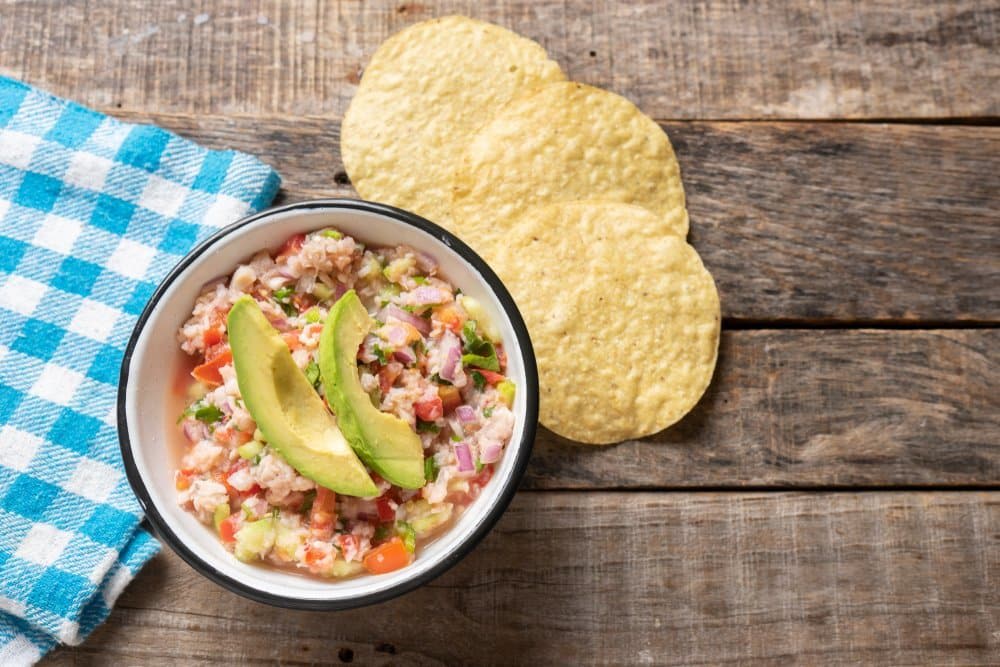
Mexican ceviche is usually made with fish, shrimp, oyster, octopus, or all of the above and is accompanied by a mixture of lemon, chili, and tomato.
You can also add ketchup, Maggi, and Worcestershire sauces.
On the other hand, traditional aguachile is made with shrimp only, but nowadays, it can also be prepared with octopus, scallops, or even fish.
It is usually served as a sharing plate in the middle of the table and almost always accompanied by cold beers.
Unlike ceviche, aguachile is only left to marinate with lime juice for about 10 minutes, so the protein must be fresh so that it has not been frozen.
Classic aguachile is served with onion and cucumber strips; in some places, it is accompanied by chili slices.
Also, ground or crushed chili peppers are added to make it hotter. So I guess you can say that aguachile is a Mexican dish while ceviche is Latin American.
Whether it’s ceviche or aguachile, I’m pretty sure you will love them both.
Next time you see any of these delicacies in a restaurant, don’t hesitate to try them with a cold beer. Salud!
The Secret of Aguachile
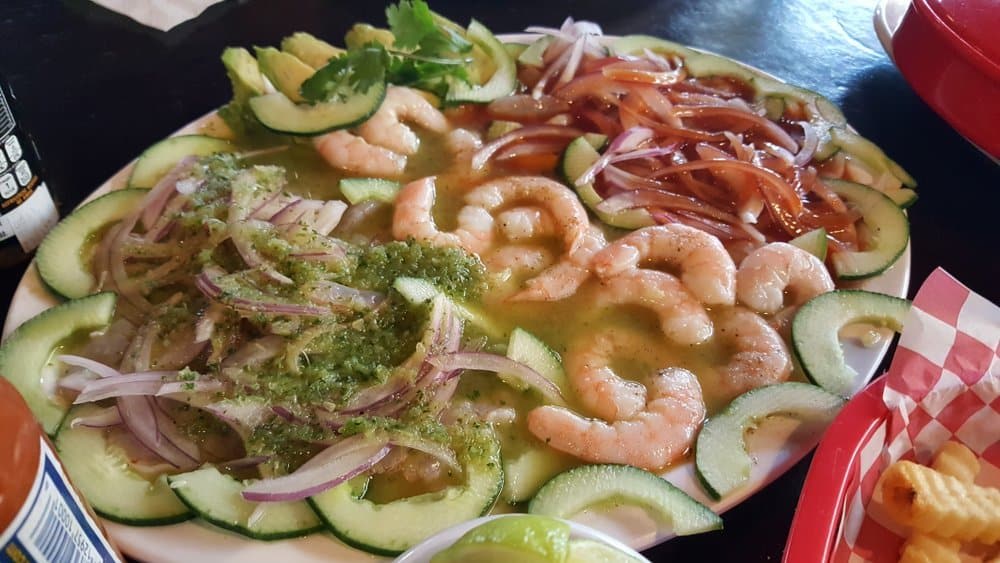
What makes this incredible and fresh dish special is the chiltepín.
This type of chile was prepared with water and salt during pre-Hispanic times, creating a special sauce that gave this dish its personality.
Originally it was prepared with machaca (shredded beef jerky), but now it has variations with seafood, such as shrimp.
Although it seems easy to get the right type of chile chiltepín, it turns out that urbanization in the Sinaloa highlands has made it difficult to obtain it in recent years.
This is because chiltepin grows in the mountains’ small, free, wild bushes.
Hence, part of the variations in this dish has to do with the type of chile.
Is Aguachile safe to eat?
Yes, aguachile is safe to eat. Given that you ensure the ingredients (especially shrimp) are fresh and clean.
I love raw seafood, and I’ve been eating it since I was a kid. Nevertheless, I’m always careful whenever I go out to eat them.
Even in my favorite oyster place near my house (in Yelapa Beach, Mexico), I always check that the oysters are fresh and super clean. Never trust raw seafood!
Mazatlan: Home of the Aguachile
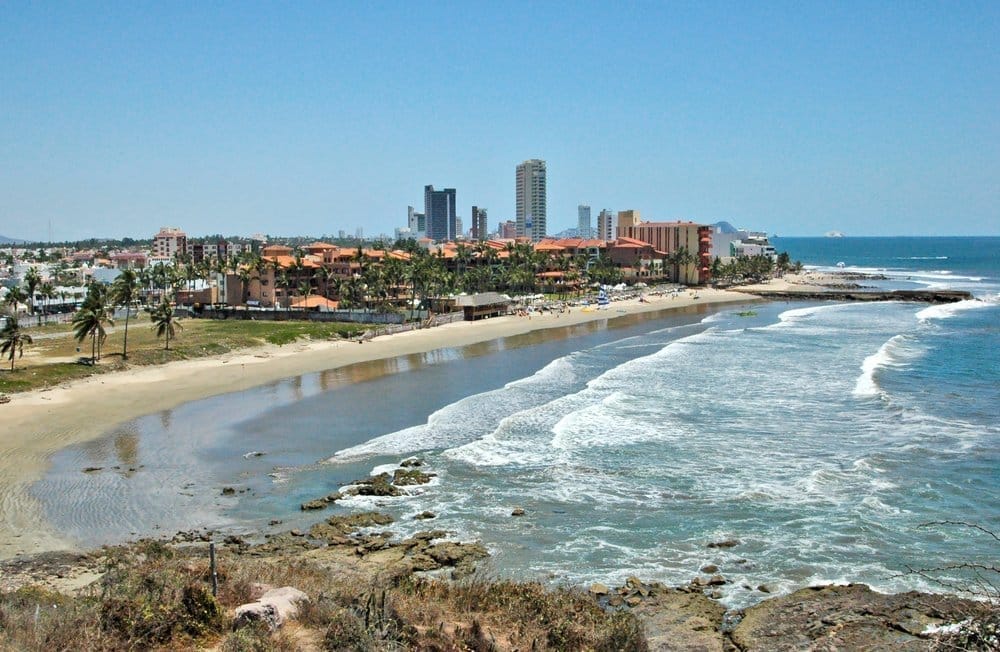
Again, aguachile is one of the most popular and emblematic dishes in Mazatlan (eating aguachile is a must if you ever visit this port).
It has also become popular and spread to other areas and states such as Nayarit, Guadalajara, Baja California, and Sonora.
Nowadays, you can practically find this delicacy almost everywhere in Mexico. However, none will be like the original one from Sinaloa.
Some other versions of this dish include ingredients such as mango, cucumber, avocado, bell pepper, tequila and mezcal.
Not to mention protein variations such as tuna, octopus, and mahi-mahi, among others.
Aguachile is a proudly Sinaloan dish that I personally love and enjoy eating (My mom is actually from Sinaloa).
Because of its simple preparation, it is one of the foods that will always go well with a party atmosphere, music, and beer, due to its freshness and spicy flavor that characterizes it.
Origins
As I mentioned earlier, the origins of aguachile date back to the Sinaloa mountains.
In the beginning, it was prepared with shredded meat in boiling water, and a few chiltepin chiles, characteristic of the region, were added to give it a spicy touch.
Aguachile means “chili-water”
Over time the recipe migrated to the coast, where the meat was quickly replaced by shrimp, which was tanned with fresh lime juice.
It didn’t take long before neighboring states like Sonora, Nayarit, Jalisco, and Baja California, started promoting it as a signature appetizer in seafood restaurants.
How to make Aguachile
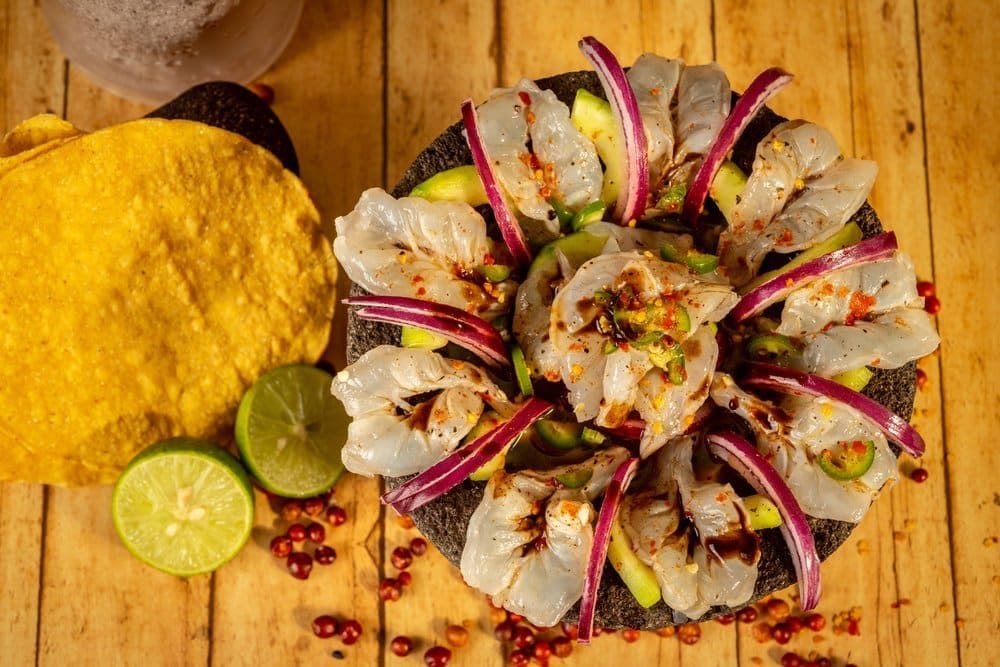
There are three ways to prepare Aguachile: traditional, mestizo, and contemporary.
The first one sticks more to the traditional recipe and is prepared with water, chiltepin chile, and fresh raw shrimp.
The mestizo is very similar to the traditional one, but the water is replaced by fresh lime juice, salt, and pepper to taste.
The contemporary aguachile is a variety of modern recipes that mix new flavors and textures.
More “exotic” ingredients include cucumber slices, mango, bell pepper, avocado, tequila, and even clam juice (clamato).
In addition, in some variants, the shrimp is replaced by tuna or mahi-mahi, creating unique recipes with unusual but delicious flavors.
Of the three ways of making aguachile, I think the “Mestizo” type is the most popular.
Everywhere I go, this is pretty much the same recipe. Here it is:
Ingredients
- 3 dozen shrimp, clean and shelled
- Serrano and/or chiltepin peppers.
- A dozen limes
- Cucumbers unpeeled and seedless
- A big sliced purple onion
- Salt and black pepper to taste
- 1 garlic clove
- A handful of fresh cilantro
Preparation
- Blend the lime with the chili of your choice (serrano or chiltepin), salt, cilantro, garlic, and a pinch of black pepper
- Pour the contents into a bowl with the shrimp, and let stand for 10 to 15 minutes
- Add cucumber and onion
- Enjoy with tostadas (rounded corn crackers)
Ceviche vs Aguachile: Conclusion
In conclusion, while both ceviche and aguachile share some similarities in terms of their use of fresh seafood and citrus-based marinades, they each offer distinct flavor profiles and culinary experiences.
Ceviche showcases a delicate balance of acidity and freshness, with a wider variety of ingredients and regional variations, making it a versatile and beloved dish across Latin America and beyond.
On the other hand, aguachile offers a bold and spicy flavor profile, highlighting the vibrant heat of chili peppers and the bracing freshness of raw seafood, particularly popular in coastal regions of Mexico.
Ultimately, whether you prefer the subtle elegance of ceviche or the fiery kick of aguachile, both dishes exemplify the beauty of using simple, high-quality ingredients to create unforgettable culinary experiences.
So, why not try both and let your taste buds decide the winner in this delicious showdown?